Abstract
1. Maturation of the excitatory and inhibitory neuromechanisms at various levels of the central nervous system was demonstrated by the convulsogenic activity induced by leptazol in the developing albino rat.
2. The somatomotor end points considered (myoclonic jerk, myoclonic seizure, tonic seizure and catalepsy) were not observed in all age groups. Tonic seizure was seen at birth, myoclonic jerks at 2 weeks of age, myoclonic seizure and catalepsy at 3 weeks of age.
3. The convulsive sequences described presented three different patterns, defining three age groups: the infant pattern (infant group: newborn-1 week old animals); the transitional pattern (transitional group: 2 week old animals); and the adult pattern (adult group: 3 week old-adult animals).
4. Effective doses were determined for the three types of convulsive sequence: MJ50 for the myoclonic major sequence (maximal end point: myoclonic jerk), MS50 for the myoclonic major sequence (maximal end point: myoclonic seizure) and the TS50 for the myoclonic-tonic-clonic sequence (maximal end point: tonic seizure).
5. The correlation of the convulsive patterns with the dose and latency variations suggests that: (a) the neuromechanisms responsible for the tonic seizure and clonic seizure, located at brainstem and spinal cord levels, function at birth and reach maturity at 3 weeks of age; (b) the neuromechanisms responsible for the myoclonic manifestations and for catalepsy, located at the striato-thalamocortical level, start functioning at 2-3 weeks of age, indicating the later maturation of the more cephalic structures.
Full text
PDF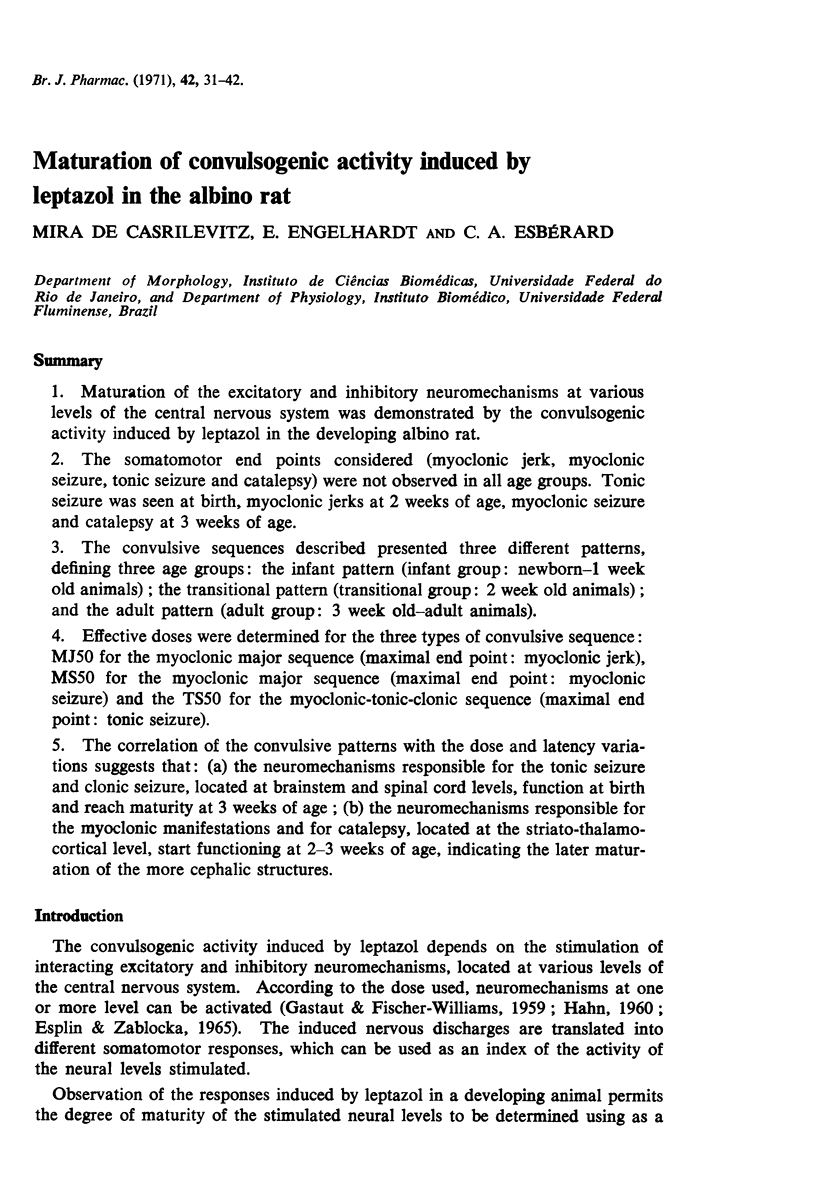
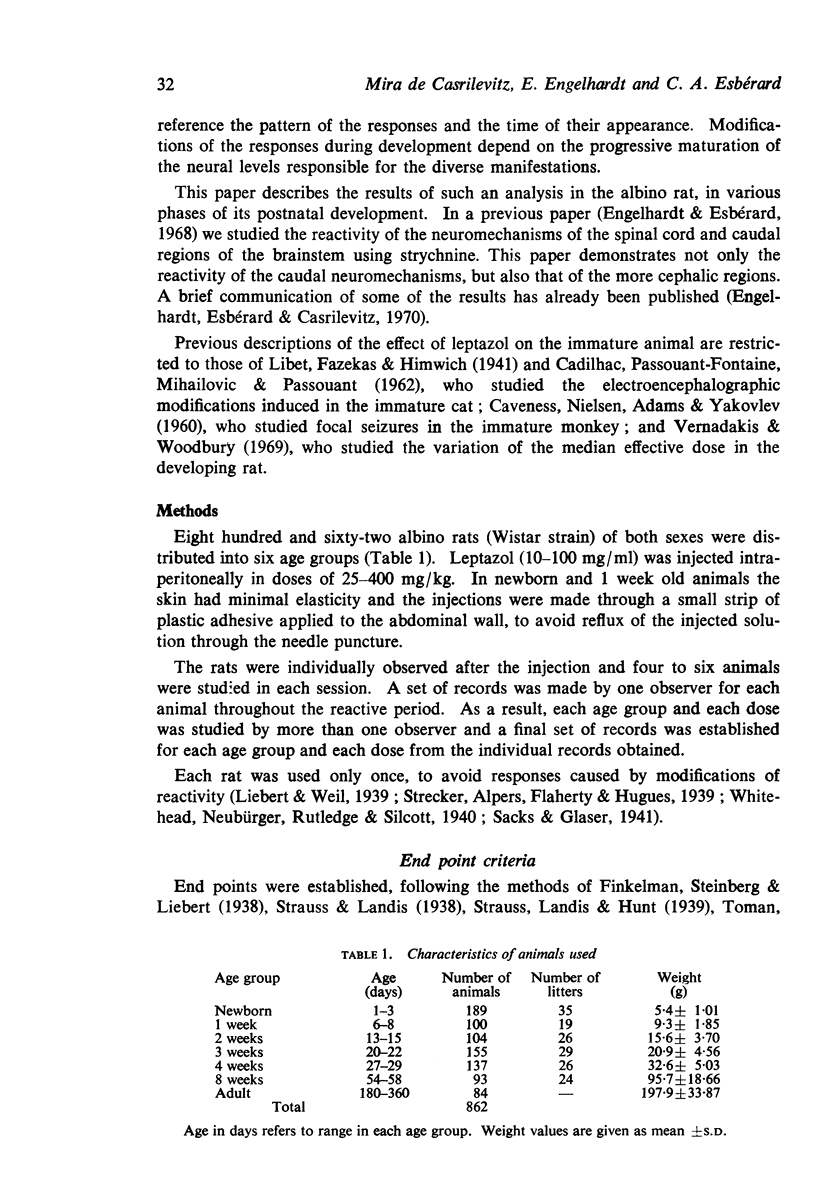
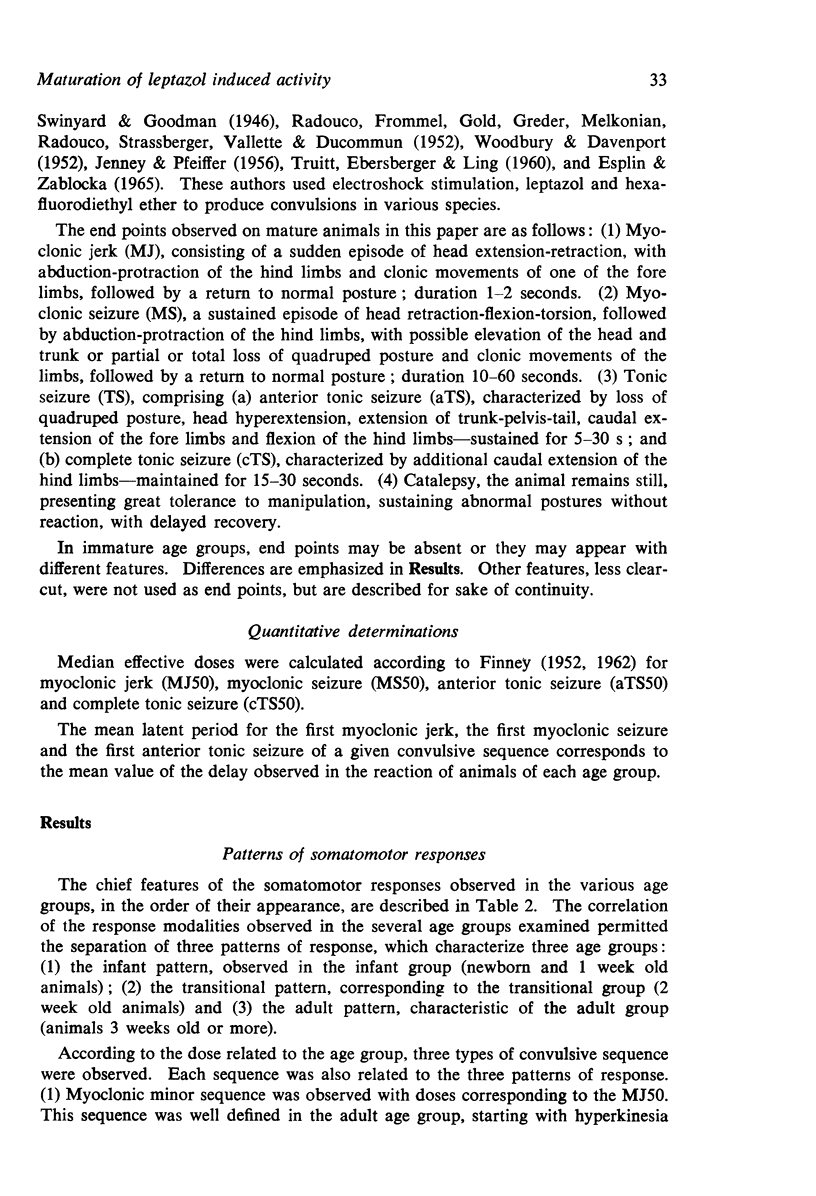
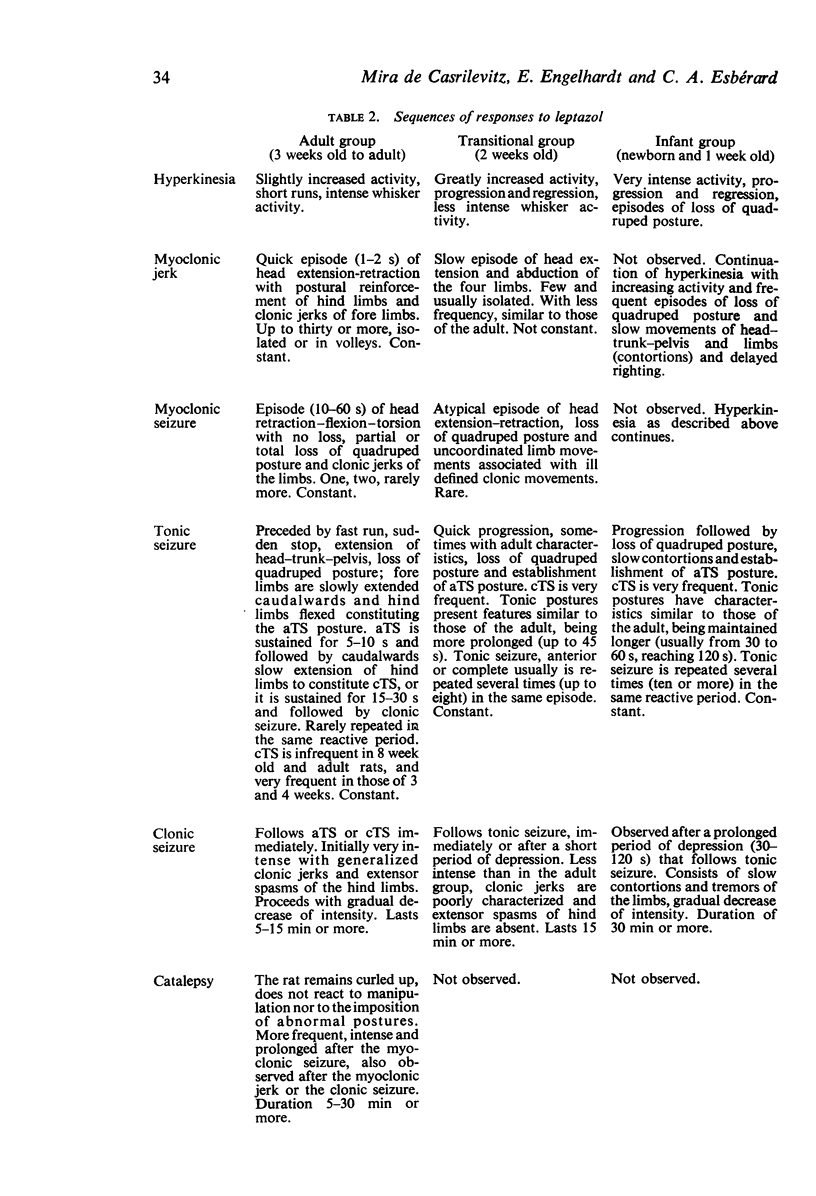
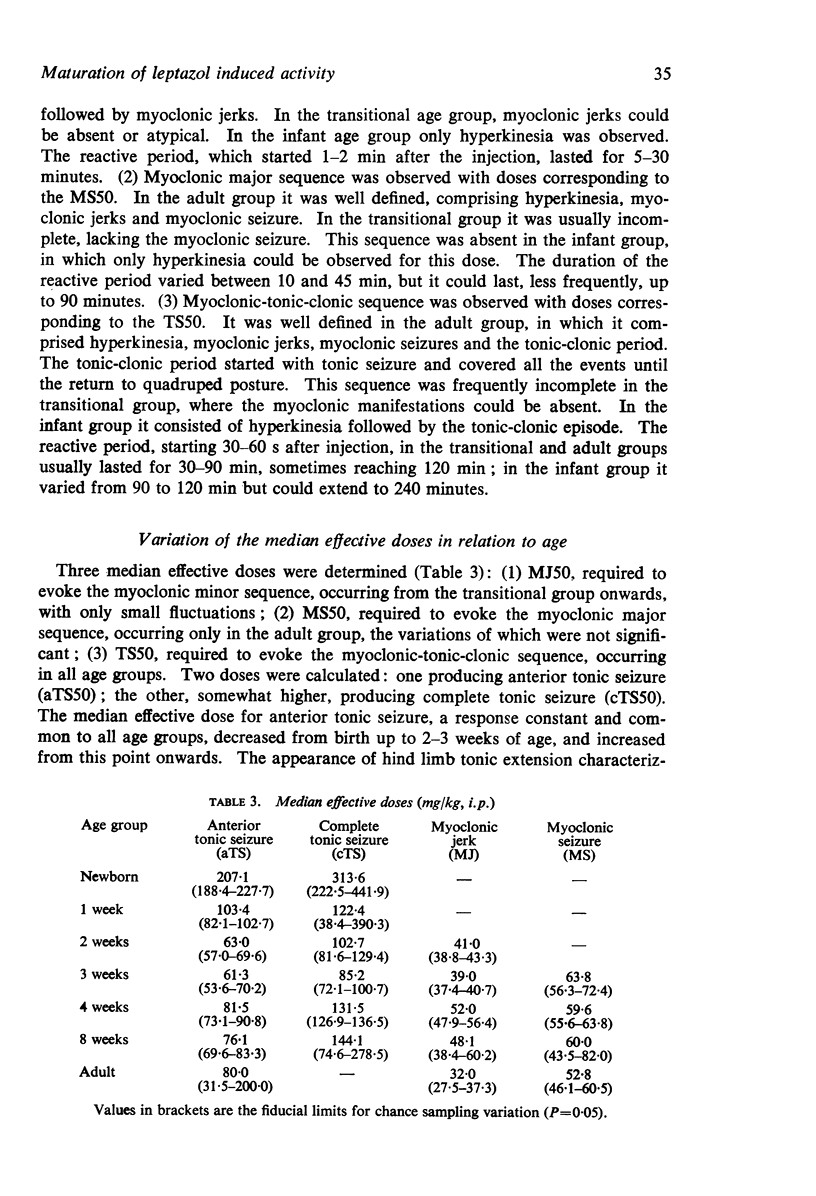
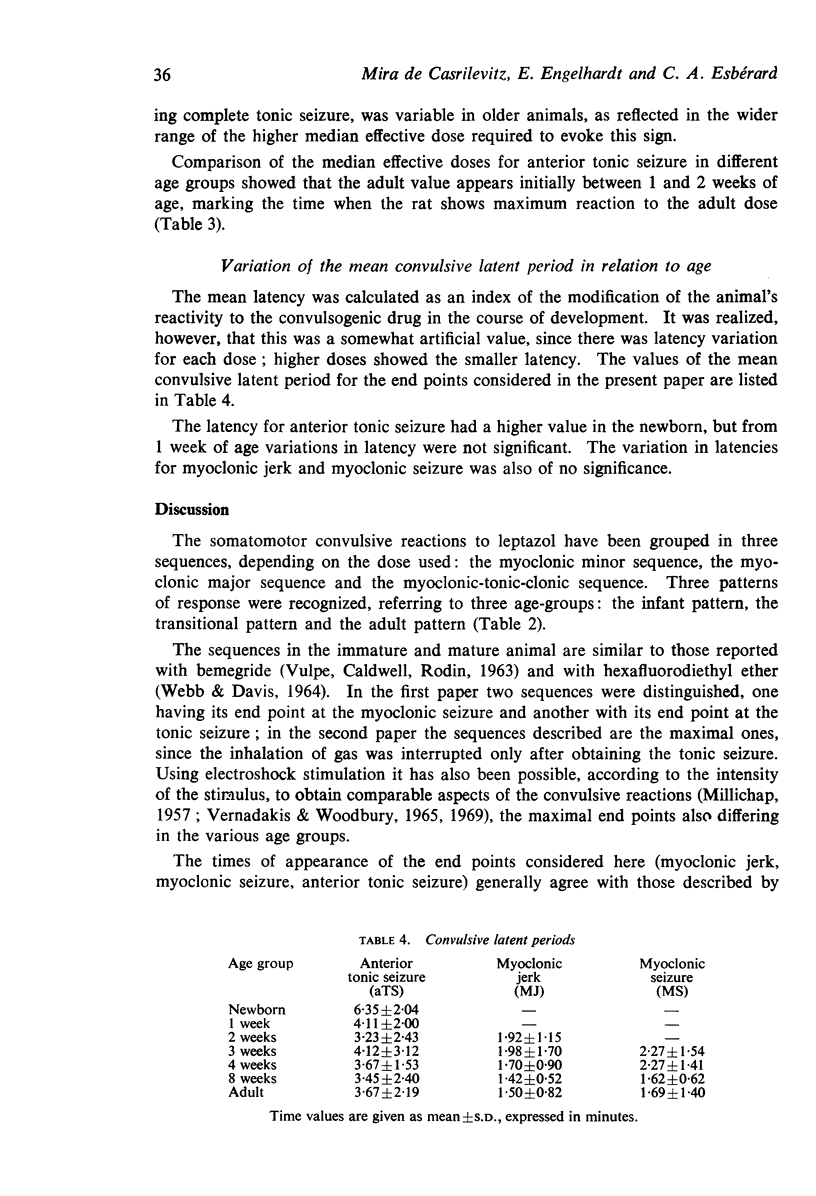

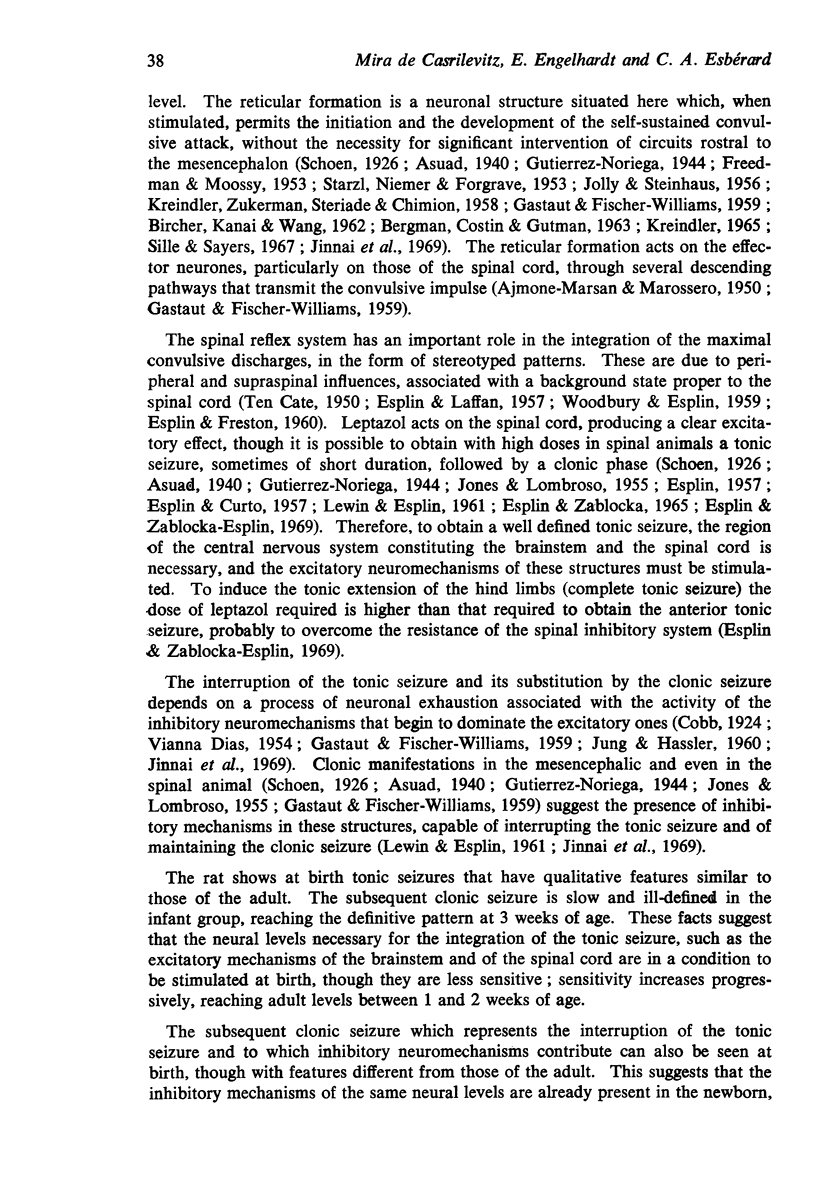
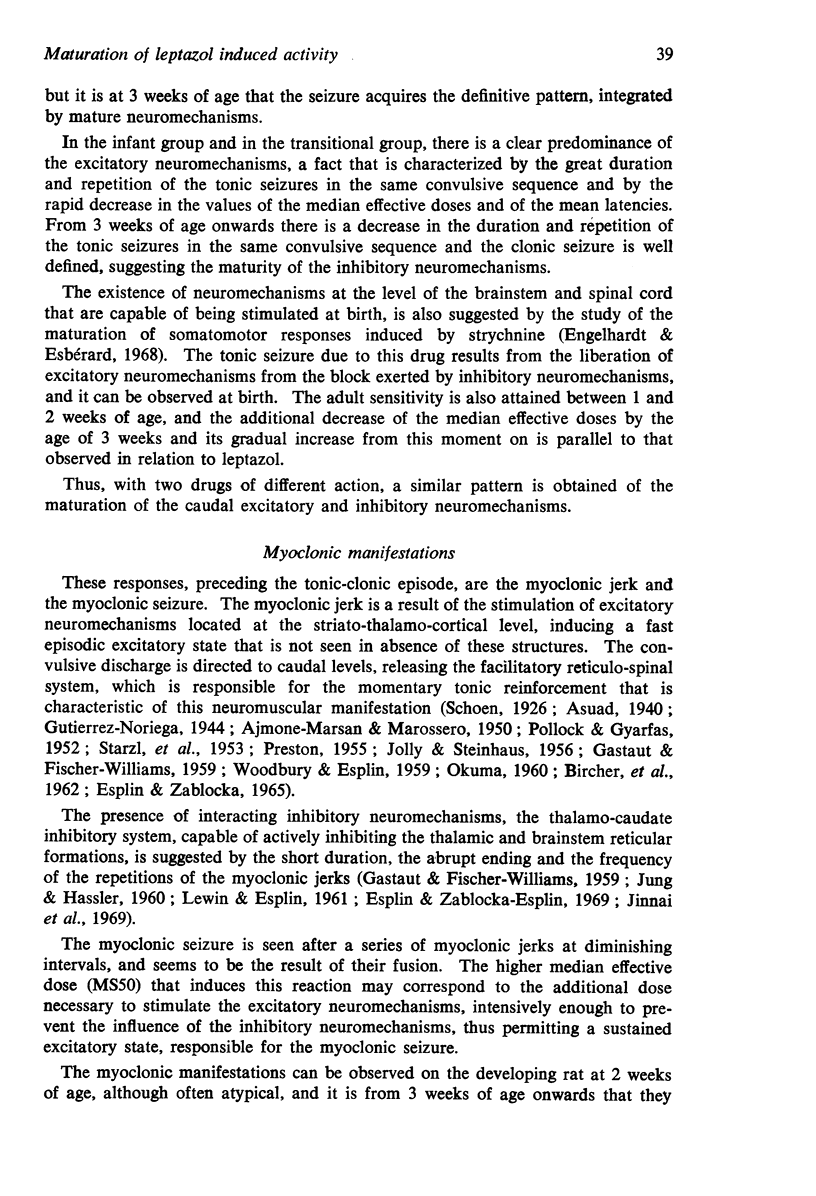
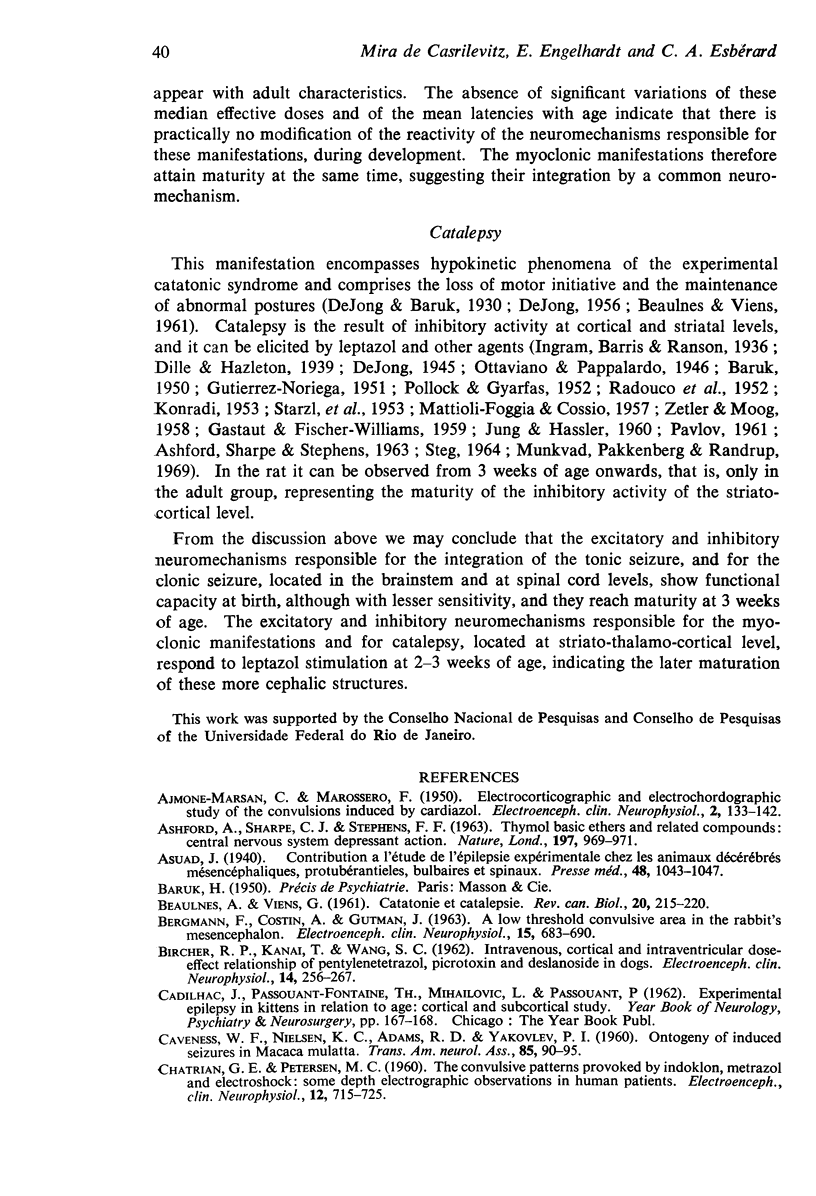
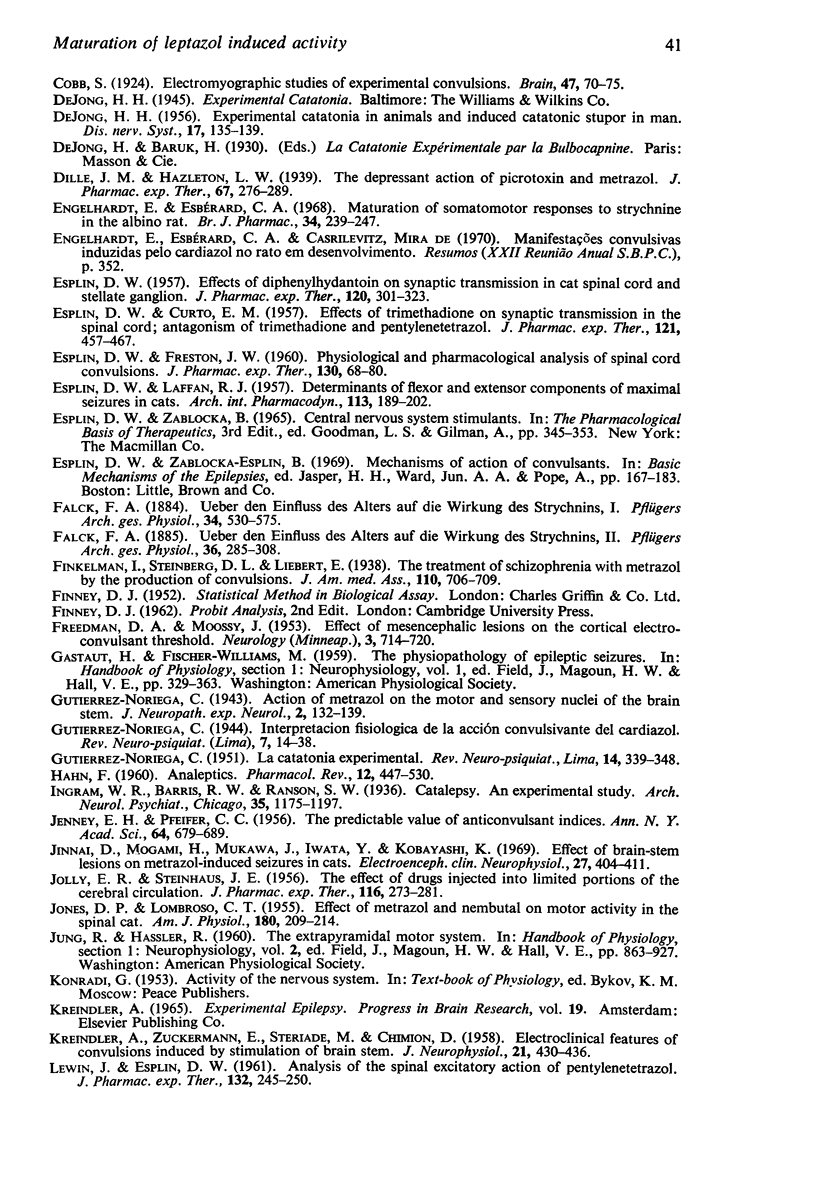
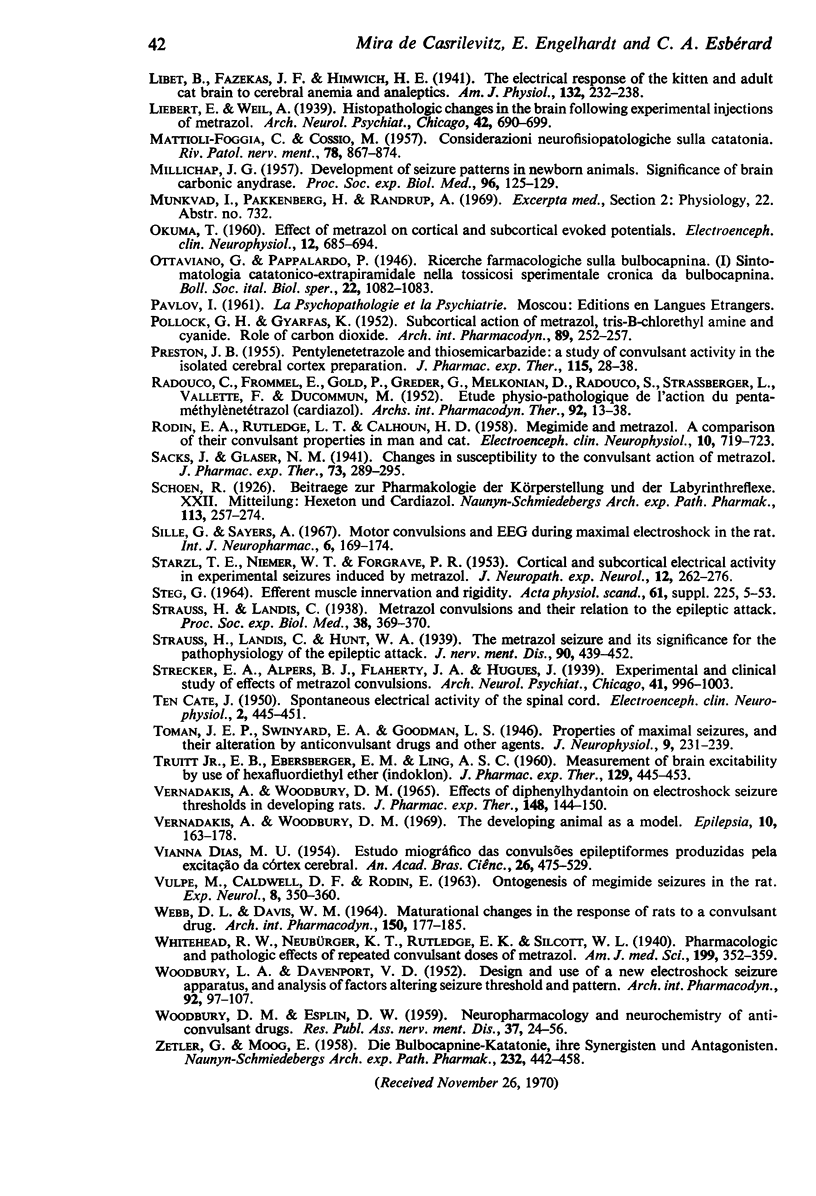
Selected References
These references are in PubMed. This may not be the complete list of references from this article.
- AJMONE-MARSAN C., MAROSSERO F. Electrocorticographic and electrochordographic study of the convulsions induced by cardiazol; some observations on the combined action of C.N.S. excitants. Electroencephalogr Clin Neurophysiol. 1950 May;2(2):133–142. doi: 10.1016/0013-4694(50)90025-3. [DOI] [PubMed] [Google Scholar]
- ASHFORD A., SHARPE C. J., STEPHENS F. F. Thymol basic ethers and related compounds: central nervous system depressant action. Nature. 1963 Mar 9;197:969–971. doi: 10.1038/197969a0. [DOI] [PubMed] [Google Scholar]
- BEAULNES A., VIENS G. [Catatonia and catalepsy]. Rev Can Biol. 1961 Jun;20:215–220. [PubMed] [Google Scholar]
- BERGMANN F., COSTIN A., GUTMAN J. A LOW THRESHOLD CONVULSIVE AREA IN THE RABBIT'S MESENCEPHALON. Electroencephalogr Clin Neurophysiol. 1963 Aug;15:683–690. doi: 10.1016/0013-4694(63)90119-6. [DOI] [PubMed] [Google Scholar]
- BIRCHER R. P., KANAI T., WANG S. C. Intravenous, cortical and intraventricular dose-effect relationship of pentylenetetrazol, picrotoxin and deslanoside in dogs. Electroencephalogr Clin Neurophysiol. 1962 Apr;14:256–267. doi: 10.1016/0013-4694(62)90035-4. [DOI] [PubMed] [Google Scholar]
- CAVENESS W. F., NIELSEN K. C., ADAMS R. D., YAKOVLEV P. I. Ontogeny of induced seizures in Macaca mulatta. I. Focal seizures. Trans Am Neurol Assoc. 1960;85:90–92. [PubMed] [Google Scholar]
- CHATRIAN G. E., PETERSEN M. C. The convulsive patterns provoked by indoklon, metrazol and electroshock: some depth electrographic observations in human patients. Electroencephalogr Clin Neurophysiol. 1960 Aug;12:715–725. doi: 10.1016/0013-4694(60)90116-4. [DOI] [PubMed] [Google Scholar]
- ESPLIN D. W., CURTO E. M. Effects of trimethadione on synaptic transmission in the spinal cord; antagonism of trimethadione and pentylenetetrazol. J Pharmacol Exp Ther. 1957 Dec;121(4):457–467. [PubMed] [Google Scholar]
- ESPLIN D. W. Effects of diphenylhydantoin on synaptic transmission in cat spinal cord and stellate ganglion. J Pharmacol Exp Ther. 1957 Jul;120(3):301–323. [PubMed] [Google Scholar]
- ESPLIN D. W., FRESTON J. W. Physiological and pharmacological analysis of spinal cord convulsions. J Pharmacol Exp Ther. 1960 Sep;130:68–80. [PubMed] [Google Scholar]
- ESPLIN D. W., LAFFAN R. J. Determinants of flexor and extensor components of maximal seizures in cats. Arch Int Pharmacodyn Ther. 1957 Dec 1;113(1-2):189–202. [PubMed] [Google Scholar]
- Engelhardt E., Esbérard C. A. Maturation of somatomotor responses to strychnine in the albino rat. Br J Pharmacol. 1968 Oct;34(2):239–247. doi: 10.1111/j.1476-5381.1968.tb07046.x. [DOI] [PMC free article] [PubMed] [Google Scholar]
- FREEDMAN D. A., MOOSSY J. Effect of mesencephalic lesions on the cortical electroconvulsant threshold. Neurology. 1953 Oct;3(10):714–720. doi: 10.1212/wnl.3.10.714. [DOI] [PubMed] [Google Scholar]
- HAHN F. Analeptics. Pharmacol Rev. 1960 Dec;12:447–530. [PubMed] [Google Scholar]
- HOLLAND DE JONG H. Experimental catatonia in animals and induced catatonic stupor in man. Dis Nerv Syst. 1956 Apr;17(4):135–139. [PubMed] [Google Scholar]
- JENNEY E. H., PFEIFFER C. C. The predictable value of anticonvulsant indices. Ann N Y Acad Sci. 1956 Nov 16;64(4):679–689. doi: 10.1111/j.1749-6632.1956.tb36840.x. [DOI] [PubMed] [Google Scholar]
- JOLLY E. R., STEINHAUS J. E. The effect of drugs injected into limited portions of the cerebral circulation. J Pharmacol Exp Ther. 1956 Mar;116(3):273–281. [PubMed] [Google Scholar]
- JONES D. P., LOMBROSO C. T. Effect of metrazol and nembutal on motor activity in the spinal cat. Am J Physiol. 1955 Jan;180(1):209–214. doi: 10.1152/ajplegacy.1954.180.1.209. [DOI] [PubMed] [Google Scholar]
- Jinnai D., Mogami H., Mukawa J., Iwata Y., Kobayashi K. Effect of brain-stem lesions on metrazol-induced seizures in cats. Electroencephalogr Clin Neurophysiol. 1969 Oct;27(4):404–411. doi: 10.1016/0013-4694(69)91449-7. [DOI] [PubMed] [Google Scholar]
- KREINDLER A., ZUCKERMANN E., STERIADE M., CHIMION D. Electro-clinical features of convulsions induced by stimulation of brain stem. J Neurophysiol. 1958 Sep;21(5):430–436. doi: 10.1152/jn.1958.21.5.430. [DOI] [PubMed] [Google Scholar]
- LEWIN J., ESPLIN D. W. Analysis of the spinal excitatory action of pentylenetetrazol. J Pharmacol Exp Ther. 1961 May;132:245–250. [PubMed] [Google Scholar]
- MATTIOLI-FOGGIA C., COSSIO M. Considerazioni neurofisiopatologiche sulla catatonia. Riv Patol Nerv Ment. 1957;78(3):867–874. [PubMed] [Google Scholar]
- MILLICHAP J. G. Development of seizure patterns in newborn animals; significance of brain carbonic anhydrase. Proc Soc Exp Biol Med. 1957 Oct;96(1):125–129. doi: 10.3181/00379727-96-23411. [DOI] [PubMed] [Google Scholar]
- OKUMA T. Effect of metrazol on cortical and subcortical evoked potentials. Electroencephalogr Clin Neurophysiol. 1960 Aug;12:685–694. doi: 10.1016/0013-4694(60)90113-9. [DOI] [PubMed] [Google Scholar]
- POLLOCK G. H., GYARFAS K. Subcortical action of metrazol, tris-b-chlorethyl amine and cyanide. Role of carbon dioxide. Arch Int Pharmacodyn Ther. 1952 Apr;89(3):252–257. [PubMed] [Google Scholar]
- PRESTON J. B. Pentylenetetrazole and thiosemicarbazide: a study of convulsant activity in the isolated cerebral cortex preparation. J Pharmacol Exp Ther. 1955 Sep;115(1):28–38. [PubMed] [Google Scholar]
- RADOUCO C., FROMMEL E., GOLD P., GREDER G., MELKONIAN D., RADOUCO S., STRASSBERGER L., VALLETTE F., DUCOMMUN M. Etude physio-pathologique de l'action du pentaméthylènetétrazol (cardiazol). Arch Int Pharmacodyn Ther. 1952 Oct 1;92(1):13–38. [PubMed] [Google Scholar]
- RODIN E. A., RUTLEDGE L. T., CALHOUN H. D. Megimide and metrazol; a comparison of their convulsant properties in man and cat. Electroencephalogr Clin Neurophysiol. 1958 Nov;10(4):719–723. doi: 10.1016/0013-4694(58)90077-4. [DOI] [PubMed] [Google Scholar]
- STARZL T. E., NIEMER W. T., DELL M., FORGRAVE P. R. Cortical and subcortical electrical activity in experimental seizures induced by metrazol. J Neuropathol Exp Neurol. 1953 Jul;12(3):262–276. doi: 10.1097/00005072-195307000-00006. [DOI] [PMC free article] [PubMed] [Google Scholar]
- Stille G., Sayers A. Motor convulsions and EEG during maximal electroshock in the rat. Int J Neuropharmacol. 1967 May;6(3):169–174. doi: 10.1016/0028-3908(67)90002-0. [DOI] [PubMed] [Google Scholar]
- VERNADAKIS A., WOODBURY D. M. EFFECTS OF DIPHENYLHYDANTOIN ON ELECTROSHOCK SEIZURE THRESHOLDS IN DEVELOPING RATS. J Pharmacol Exp Ther. 1965 May;148:144–150. [PubMed] [Google Scholar]
- Vernadakis A., Woodbury D. M. The developing animal as a model. Epilepsia. 1969 Jun;10(2):163–178. doi: 10.1111/j.1528-1157.1969.tb03841.x. [DOI] [PubMed] [Google Scholar]
- WEBB O. L., DAVIS W. M. MATURATIONAL CHANGES IN THE RESPONSE OF RATS TO A CONVULSANT DRUG. Arch Int Pharmacodyn Ther. 1964 Jul 1;150:177–185. [PubMed] [Google Scholar]
- WOODBURY D. M., ESPLIN D. W. Neuropharmacology and neurochemistry of anticonvulsant drugs. Res Publ Assoc Res Nerv Ment Dis. 1959;37:24–56. [PubMed] [Google Scholar]
- WOODBURY L. A., DAVENPORT V. D. Design and use of a new electroshock seizure apparatus, and analysis of factors altering seizure threshold and pattern. Arch Int Pharmacodyn Ther. 1952 Oct 1;92(1):97–107. [PubMed] [Google Scholar]
- ZETLER G., MOOG E. Die Bulbocapnin-Katatonie, ihre Synergisten und Antagonisten. Naunyn Schmiedebergs Arch Exp Pathol Pharmakol. 1958;232(2):442–458. [PubMed] [Google Scholar]
- ten CATE J. Spontaneous electrical activity of the spinal cord. Electroencephalogr Clin Neurophysiol. 1950 Nov;2(4):445–451. doi: 10.1016/0013-4694(50)90080-0. [DOI] [PubMed] [Google Scholar]


